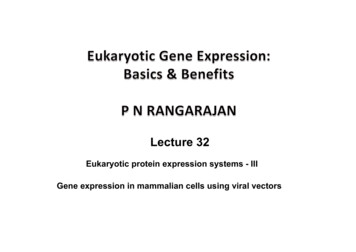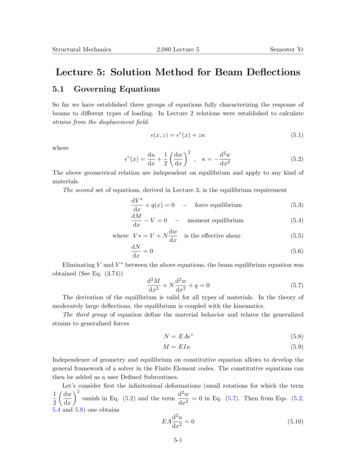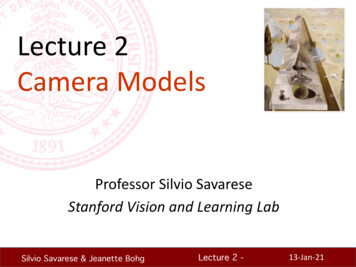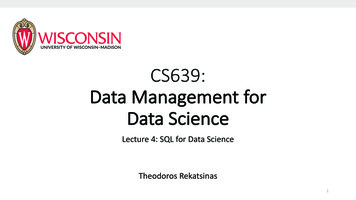
Transcription
Lecture 32Eukaryotic protein expression systems - IIIGene expression in mammalian cells using viral vectors
Eukaryotic protein expression systems-I (lecture 30)Protein expression in yeast and insect ------------------------Eukaryotic protein expression systems-II (lecture 31)Protein expression in mammalian cells (non viral vectors)Cell-free protein expression ----------------------------Eukaryotic protein expression systems-III (lecture 32)Protein expression in mammalian cells (viral -----------------------------Human gene therapy (lecture -----------------------Eukaryotic protein expression systems-IV (lecture 34)Protein expression in plant cells and generation of transgenic --------------------------Transgenic animals (lecture 35)
Introduction of DNA into animal cellsCalcium PhosphateCationic Lipids,LiposomesElectroporationDEAE dextranDirect DNA InjectionsNon viral gene delivery techniques
Non viral gene delivery1. Efficiency of transfection2. Nuclear localization of the vectorThe nuclear envelope is a major barrier for successful nonviral transfection ofexogenous genes and their subsequent expression both in vitro and in vivo.The nuclear envelope poses a major problem for transfections in which exogenous DNAis delivered into the cytoplasm.After delivery to the cytoplasm, nucleic acids rapidly become complexed with cellularproteins that mediate interactions with the cellular machinery for trafficking.A P Lam and D A DeanProgress and prospects: nuclear import of nonviral vectorsGene Therapy 17, 439-447 (April 2010)
Viruses as gene delivery vehiclesPapova (SV40, Polyoma)Papilloma (BPV)Parvo (Adeno associated , AAV)AdenoHerpes/VacciniaRetroviruses (MMTV)Lentiviruses (HIV)Viruses have evolved specialized molecularmechanisms to efficiently transport theirgenomes inside the cells they infect.
Construction of a viral vectorGeneration of a recombinant virus
Construction of a viral vector and generation of a recombinant virusPromoter/EnhancerP1P2GOI-1P3regulatoryP4 elementsGOI-2GOI: gene of interestPackaging cell linescell lines that packagerecombinantretroviralRNAs into CMVP2RECOMBINANT VIRUS
Gene of interestThe recombinant viruses that emerge out ofthe packaging cell lines arereplication incompetentREPLICATION-DEFECTIVE RECOMBINANT VIRUSES
REPLICATION-DEFECTIVERECOMBINANT VIRUSESVirusxProtein of interestINFECT TARGET CELLSTRANSGENE EXPRESSIONPROTEIN OF INTEREST
Gene expression in mammalian cells using recombinant virusesViral genomeVirusesRecombinant viral vectorRecombinant virusesRecombinant adenoviral vectorRecombinant adenovirusRecombinant adeno associated viral (AAV) vectorRecombinant AAVRecombinant retroviral vectorRecombinant retrovirusRecombinant lentiviral vectorRecombinant lentivirus
Gene transfer and expression using DNA virusesADENOVIRUSESADENO ASSOCIATED VIRUSES
ADENOVIRUSADENOVIRAL VECTORRECOMBINANT ADENOVIRUS Nonenveloped particle Contains linear double stranded DNA Does not integrate into the host genome Replicates as an episomal element in the nucleus
Adenoviral Vector: ΔE1/ΔE31. Human adenoviral type 5 (Ad5) with ΔE1/ΔE3.2. Replication-incompetent (replication-deficit).3. Insert up to 8 kb of foreign DNA.4. Transient non-cytopathic (non-lytic) infection.Packaging cells: HEK 293 cells stably expressing the Ad5 E1.Replication-incompetent adenovirus propagates only in those celltypes that express the E1-encoded transcomplementing factors.
MANY ADENOVIRAL EXPRESSION SYSTEMSARE AVAILABLE l.asp?product id 152613&tabno 2
Adenovirus Mammalian Expression SystemRecombinant Adenovirus-Adeno-X www.Clontech.comAdeno-X MethodTo produce recombinant adenovirus, insert your gene of interest into themultiple cloning site of the pShuttle2 vector’s expression cassette. Then,transfer the cassette into the ligation-ready Adeno-X Viral DNA using thetwo extremely rare restriction enzyme sites, PI-Sce I and I-Ceu I.Subsequent digestion with Swa I removes self-ligated or nonrecombinantadenoviral DNA. Transform E. coli strain with the ligation mixture andidentify recombinant clones by restriction enzyme digests. Then transfecta low-passage HEK 293 cell line with linearized recombinant adenoviralDNA and harvest recombinant adenovirus several days later
ADENOVIRAL VECTORSCell-cycle independent.Primary cells as well as transformed cell lines.Host tropism: many different animal species includinghumans, non-human primates, pigs, rodents, mice, &rabbits.Tissue tropism: all human cell types - including skin,muscle, bone, nerve, and liver cells - are susceptible.Advantages:Higher titerEfficient transduction of nondividingcells in vitro and in vivoDisadvantages:ToxicityImmunological responsePrior exposure
ADENO ASSOCIATED VIRUS (AAV)AAV VECTORRECOMBINANT AAV AAV is a simple, non-pathogenic, single stranded DNA virusdependent on the helper virus (usually adenovirus) to replicate. It has two genes (cap and rep), sandwiched between invertedterminal repeats that define the beginning and the end of the virusand contain the packaging sequence. The cap gene encodes viral capsid proteins and the rep geneproduct is involved in viral replication and integration. It can infect a variety of cell types and in the presence of the repgene product, the viral DNA can integrate preferentially into humanchromosome 19. AAV is a defective virus and needs a helper virus (adenovirus) forits replication. AAV is not known to cause disease.
AAV vectors To produce an AAV vector, the rep and cap genes are replaced with a transgene. The total length of the insert cannot exceed 4.7 kb, the length of the wild type genome.Gene of interest Production of the recombinant vector requires that rep and cap areprovided in trans along with the helper virus gene products.
Adeno-associated virus vectorsAdvantages:All viral genes removedSafeTransduction of nondividing cellsStable expressionDisadvantages:Small genome limits size of foreign DNALabor intensive productionStatus of genome not fully elucidated
Vaccinia virusRecombinant Vaccinia virus Expression VectorRecombinant vaccinia virus
Generation of recombinant vaccinia virusesThe vaccinia virus genome is about 187000 base pairs.The large size of the vaccinia virus genome prevents construction of recombinantgenomes by restriction endonuclease cleavage and re-ligation with foreign DNA.A two-step strategy has been utilized for generating recombinant vaccinia viruses:In the first step, a plasmid is constructed that contains the foreign gene linked to avaccinia virus promoter.In the next step, this chimeric gene is inserted into the vaccinia virus genome byhomologous recombination between virus and plasmid DNA in vivo
Generation of a recombinant vaccinia virus
Modified vaccinia Ankara (MVA)MVA was derived from wild type vaccinia virus strain Ankara, by over570 serial passages in chicken embryo fibroblast cells.The resulting MVA strain lost the capacity to productively infectmammalian cells and had six major deletions of DNA totaling 31,000base pairs (bp), including at least two host-range genes.As a result, MVA is severely host cell restricted: it grows well in aviancells but not human and most other mammalian cells.
Gene transfer and expression using recombinant RNA viruses:RETROVIRUSES
RetrovirusesEx. Moloney murine leukemia virus (Mo-MLV)Gag is a polyprotein and is an acronym forGroup Antigens (ag).Pol is the reverse transcriptase.Env in the envelope protein.
Transcription proceeds through the genome and mRNA is polyadenylated andprocessed using signals in transcribed regions from the 3' LTR at the end of thetranscribed region.The full-length message is spliced to lead to production of envelope proteinsUnspliced full-length mRNA can give rise to gag-pol proteins.Gag and Pol are made as either Gag protein or a Gag-Pol precursor. A viral proteasecleaves the precursor into multiple subunits with varying functions.The Env protein is also translated as a precursor which is cleaved by endogenousproteases to yield the mature surface glycoprotein.Translated proteins assemble a retroviral particle at the cell surface.Full-length genomic unspliced mRNA (containing a packaging signal termed Psi) isbound by gag-derived proteins and incorporated into the budding particle.
Production of a recombinant retrovirusΨGAGPOLENVGene of interest1. Introduce the vector into packaging a cell line that expresses theviral gag, pol, and env genes - necessary for particle formation andreplication.2. Retroviral expression vectors provide the packaging signal Ψ,transcription and processing elements, and a target gene.3. Inserts of up to 6.5 kb can be efficiently packaged.4. The viral env gene, expressed by the packaging cell line, encodes theenvelope protein, which determines the range of infectivity (tropism)of the packaged virus.
Unigenomic packaging cell lines
Multiple recombination events are requiredfor the emergence of wild type virus
Altering the tropism of a recombinant retrovirusThe viral env gene, expressed by the packaging cell line, encodes theenvelope protein, which determines the range of infectivity (tropism) of thepackaged virus.Viral envelopes are classified according to the receptors used to enter hostcells:Ecotropic virus can recognize a receptor found on only mouse and rat cells.Amphotropic virus recognizes a receptor found on a broad range ofmammalian cell types.Dualtropic virus recognizes two different receptors found on a broad range ofmammalian cell types.A pantropic packaging cell produces virus that can infect both mammalian andnon-mammalian cells. Using this cell line, virions are pseudo-typed with theenvelope glycoprotein from the vesicular stomatitis virus (VSV-G) whichmediates viral entry through lipid binding and plasma membrane fusion.Stable expression of the VSV-G envelope protein is toxic. Thus, the packagingcell line only contains the viral gag and pol genes. Virus is produced bytransiently co-transfecting a retroviral expression vector and pVSV-G into apantropic packaging cell line.
www.clontech.com
http://www.stanford.edu/group/nolan/plasmid maps/pmaps.html
Retroviral vectors- Limitations A critical limitation of retroviral vectors is their inability to infect nondividing cells. Random integration of vector DNA into the host chromosome.
Gene transfer and expression using RNA viruses:LENTIVIRUSES
Lentiviruses Belong to the retrovirus family but can infect both dividing and non-dividing cells. They are more complicated than retroviruses, containing an additional six proteins, tat,rev, vpr, vpu, nef and vif. Human immunodeficiency virus (HIV) has been disabled and developed as a vector for invivo gene vifgagvprpolLTRvpuenvLTRnef
LentiviralvectorPackagingcellsThe HIV-1 env glycoprotein has a highly restricted host range in that it infects cellscontaining CD4 and coreceptors. To broaden the host range of lentiviral vectors,they are pseudotyped with the vesicular stomatitis virus glycoprotein (VSV-G) env.
1st Generation Vectors Limited homology between vector and helper sequencesSeparation of helper plasmidsStill retains HIV accessory genes in the packaging plasmid
2nd Generation VectorsElimination of accessory genes from packaging plasmid No effect on vector titer Retains property of transduction of many dividing and non-dividing cells Increased safety margin
3rd Generation VectorsSelf-inactivating (SIN) vectors Deletion in the enhancer region of the 3’ U3 of the long terminal repeat (LTR) Results in a transcriptionally inactive vector that can not be converted into afull length RNA Reduces likelihood of replication competent lentivirus regeneration Hampers mobilization by wild-type HIV May reduce risk of tumorigenesis via promoter insertion
http://www.clontech.comVSV-G lentiviral packagingThe standard Lenti-X HTX Packaging System produces VSV-G pseudotypedlentivirus, which readily infects virtually all types of cells.Ecotropic Lentiviral packagingThe Lenti-X HTX Ecotropic Packaging System produces lentiviruspseudotyped with the MLV ecotropic envelope glycoprotein, which allows you tolimit transduction to mouse and rat cells
http://www.clontech.comThe Lenti-X HTX Packaging System. A lentiviral vector and theLenti-X HTX Packaging Mix are cotransfected into 293T cells usingthe Xfect transfection system.High titer virus supernatants can be obtained within 48 hr aftertransfection
Recombinant lentiviruses represent the latestgeneration of powerful, multipurpose vectorsfor delivering genes into almost anymammalian cell type, including primarycultures, nondividing cells, and stem cells.
Lenti-X vectors contain sequenceelements that facilitate lentiviralpackaging,boosttransgeneexpression, or both.Among them are the HIV-1 LTRsand packaging signal (Y), a Revresponse element (RRE), thecentralpolypurinetract/centraltermination sequence (cPPT/CTS),and the woodchuck hepatitis virusposttranscriptionalregulatoryelement (WPRE).http://www.clontech.com
Induced expression in the Tet-Off Advanced and Tet-On Advanced Systems.The Tet-controlled transactivators are fusion proteins that contain a DNAbinding TetR domain joined to three minimal transcription activation domainsfrom HSV VP16.In Tet-Off Advanced Systems, the basal state is maintained in the presenceof Dox, whereas the withdrawal of Dox triggers the activated state.In contrast, Tet-On Advanced Systems are activated in the presence of Dox.Induction in either system produces high-level transcription of your gene fromPTight.
http://www.clontech.comRetroNectin greatly enhances virus-mediated gene transduction.RetroNectin is a chimeric recombinant peptide consisting of 3functional domains derived from human fibronectin, that bind eithercell surface proteinsor virus particles.The enhancement is likely due to the colocalization of virus andcells on RetroNectin molecules.
http://www.clontech.com/images/brochures/BR8Y2848 LentiX IN.pdf
http://www.clontech.com/images/pt/PT3132-1.pdf
Annu. Rev. Biochem (2005) 74:711–38
The standard Lenti-X HTX Packaging System produces VSV-G pseudotyped lentivirus, which readily infects virtually all types of cells. Ecotropic Lentiviral packaging The Lenti-X HTX Ecotropic Packaging System produces lentivirus pseudotyped with the MLV ecotropic envelope glycoprotein, whic










